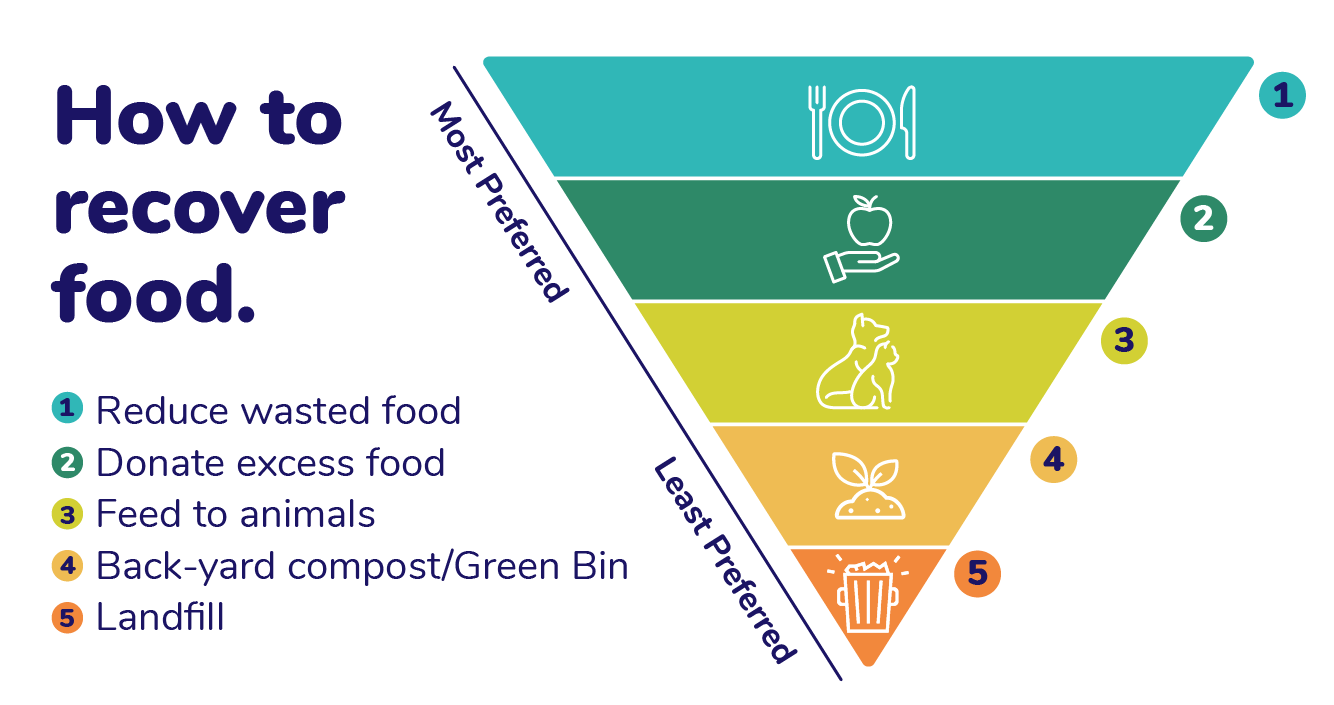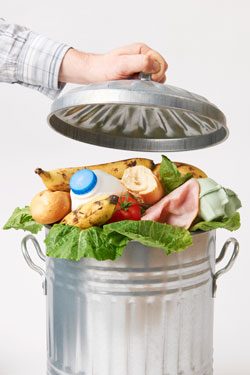Food Waste
Food Waste
On this page
- What is food waste?
- Identifying food waste
- Why is reducing food waste important?
- How can I reduce my food waste?
- Food safety & healthy eating
What is food waste?
Food waste is more than simply throwing out your spoiled food and scraps. Nearly a third of all food produced in Canada is wasted and more than 60 per cent of that waste is avoidable.
By working to reduce this avoidable waste, you can help limit the impact on climate change. Food contributes to climate change by emitting greenhouse gasses (GHGs) such as methane (CH4) and carbon dioxide (CO2). GHGs are also released throughout the supply chain via harvesting and processing methods as well as transportation. Every time food is wasted, valuable resources such as energy, water and soil nutrients are also lost. By preventing food waste, these resources can be used more sustainably.
By planning, buying what you need and storing food properly we can avoid food waste in our landfill. Only dispose of food when it starts to spoil, ideally in compost. The food recovery hierarchy illustrates this order of preference.

Reducing waste = climate action
Change for climate by reducing your waste and by diverting it properly. Garbage sent to landfill contributes to climate-changing greenhouse gas emissions.
Identifying food waste
Understanding the terminology of food waste is important in becoming more aware.
- Food loss: food that is lost before it even reaches store shelves, including during harvesting, shipment, storage and in cosmetic standards for saleable food.
- Food waste: food that made it to grocery store shelves and once was or is still appropriate for human consumption but that was disposed of. This can be due to food spoilage, excess within markets or individual consumer habits. Food waste contains two components:
- Edible food waste: food that could have been consumed
- Inedible food waste: portions of foods that are not suitable for consumption including, shells, bones, peels, coffee grounds and tea, etc.
- Food wastage: any food lost due to deterioration or waste; this includes food loss and food waste.
Why is reducing food waste important?
In Canada, more than 60 per cent of the food wasted could have been consumed at some point. The most commonly wasted food items in Canada are as follows: produce (accounts for nearly half of the waste), followed by leftovers, and bread/baked goods.
Economy
Every year, the average Canadian household discards over $1,100 worth of food. This represents more than $17 billion worth of food wasted in Canada yearly! In developed countries like Canada, food wastage is almost 10 times more likely to happen after the production and harvesting stages than in developing countries. This is largely due to poor crop planning, inadequate food literacy skills, as well as higher quality standards within the supply chain.
Environment
The average North American creates over 40 per cent more GHGs from food waste than the global average per person.
- In North America, the largest amount of food waste related GHGs is created by the waste of meat, vegetables, and bread/grains products. Wasted meat generates more GHGs despite having lower rates of wastage since it includes gasses created from livestock feed, land and water use and methane produced by livestock
- Land: In 2007, an estimated 28 per cent of the world’s agricultural land was used to produce food which was wasted. If that land were a country, it would be the second largest– even larger than Canada! Meat and dairy production is considered the greatest contributor to land usage but accounts for only 11 per cent of the total food wastage. This land usage comes at a cost to ecosystems as agriculture accounts for two thirds of threats to species worldwide.
- Water: 92 per cent of all water use by humanity is for the production of food. That is equivalent to using half of Lake Erie’s water every year! Meat and dairy production makes up the largest portion of water used for agriculture in the form of animal feed and drinking water.
- Transportation: Transportation of food products contributes to GHG emissions as these often have to be shipped between the various stages of the supply chain. If the food is wasted, it must then be transported to the composting facility or the landfill. Reducing your waste helps decrease the costs and environmental impacts associated to transportation.
Social
Learning to respect food by viewing it as the valuable resource it is can help lead to a decrease in food waste and ultimately GHG emissions. Developing food skills brings greater knowledge and appreciation for food. Being involved in the growing, harvesting, preparation and cooking of food strengthens our commitment to it and avoidance to waste the fruit of our labour.
Food brings people together and can strengthen social connections in our community. Those that care about food waste are coming together to form partnerships to advocate and share ways to reduce the waste of this valuable resource.
How can I reduce my food waste?
Almost half of the food wasted in Canada occurs at the consumer level. Some of this waste is largely unavoidable as it is caused by items not meant to be eaten such as shells, bones, coffee grounds and some vegetable peelings. This is called inedible food waste. Edible food waste is the food that could have been eaten, but was thrown in the compost or the trash. Such waste can be avoided by being conscious of how much you buy, storing food appropriately to keep it fresh and using it up before it goes bad.
Plan your meals and shop accordingly
- Meal planning is a great way to reduce food waste at home. Plan your meals for a given period of time depending on how often you are able to go shopping.
- Check your fridge and pantry to confirm what you already own to avoid buying doubles and to prioritize cooking with items closest to their best before dates.
- Use portion planners to provide you with guidance on serving sizes. This is useful whether you are planning for one person or many people.
- Before going grocery shopping, write a list based on your meal plan and stick to it to prevent over-buying.
- Only shop on a full stomach. Shopping hungry may lead to impulse buying or buying more than you need.
- Buy less, more often to avoid food going to waste and spoiling.
- Buy non-perishable foods in bulk; this will help you save money and reduce packaging waste.
- Avoid “buy one get one free” deals – especially on perishables – as they will result in a waste of food and money if you don’t use all of it.
Food Safety & Healthy Eating
What is the difference between best-before and expiry dates?
Best before and expiry dates are often confused with one another but they are not the same. Best before dates refer to the time at which the original food quality (taste, colour and nutrients) is expected to start decreasing. They do not determine food safety. For instance, a loaf of bread will likely be perfectly safe to eat a few days past its best before date, but it may be slightly drier and less flavourful than if it were fresh.
Expiry dates are based on food safety guidelines; food items should not be consumed past their expiry date. For example, infant formulas should be discarded past their expiry dates as they may not be safe for consumption beyond that time.
Compost the food that has gone bad (spoiled, rotten, mouldy… as a rule of thumb; if it smells, looks or taste off, toss it) in a green bin or backyard composter.
See the Ontario Ministry of Health and Ministry of Long-Term Care information on correct food handling.
Store food properly
- Store food properly to prevent spoilage and make it last as long as possible. Place pantry items such as grains and nuts in airtight containers in a cool, dry area. Keep ethylene-releasing fruits such as apples, bananas and stone fruit out of airtight containers or plastic bags so that they don’t ripen too fast. Freeze food items in airtight containers to save them for later and use icepacks to keep food fresh when on the go.
- Refer to storage guidelines to know where to store individual items and at what temperature they should be kept. Avoid putting highly perishable items in the door of your fridge as this is the warmest area. Keep eggs, meat and seafood on the bottom shelf. Dairy products should be stored on the upper shelf as this prevents their temperature from fluctuating. The crisper drawers are ideal for fruits and vegetables, but keep ethylene-emitting produce such as stone fruit, tomatoes, bananas and avocados separate.
- Refrigerate or freeze leftovers as soon as possible after cooking to prevent foodborne illnesses and preserve quality.
- Your fridge should be kept at 4oC (40 oF) or below for optimal food preservation. This slows the growth of bacteria that could make your food go bad.
- Many items can be frozen or canned to extend their shelf life.
- Your freezer should be kept at –18 oC (-0 oF) or colder for optimal food preservation. Make sure to keep foods in airtight packages or containers to retain moisture and keep air out. Avoid putting warm food directly in the freezer as this will create unwanted temperature fluctuations that may cause larger ice crystals to form and cause freezer burn. Try to eat foods within three months of freezing them.
- Refer to these canning guidelines to help you preserve produce so you can enjoy them throughout the year.
Use it
- Use foods that are closest to their best before dates while they are still fresh and make sure they are visible in your pantry and fridge.
-
- Cook once, eat twice is planning to cook foods that can be enjoyed for dinner one night, then used in a meal the next day. For example using left-over meat or beans in: quesadillas, soups, toppings on salads, sandwiches, and tacos.
- Love your leftovers:
- Use ripe fruit in smoothies, baked goods and preserves. Use left-over vegetables in in stir fry, omelettes, fajitas, toppings on pasta
- Use stale bread: croutons, bruschetta or add some egg, milk and cinnamon for French toast
- Use leafy greens: even if they are soft or wilted, leafy greens such as spinach and kale can be used in pesto, smoothies, omelettes or even as toppings on pizza
- Get creative with your leftovers! Show us your recipe ideas using the #WasteNotYGK.
- When hosting meals, serve food buffet style so guests can select the appropriate portions for themselves. Provide children with smaller portions so they can return for seconds if they are still hungry.
- Ask guests to bring their own containers so they can bring leftovers home.
- To reduce waste of leftovers
- Make large batches of food and freeze them for later. Ensure you label and date them.
- Freeze fresh ingredients
- Canning, pickling or drying
- Revive food such as wilted produce, stale bread or burnt dishes
Healthy diets
An eating pattern that is higher in plant-based foods and lower in animal-based foods can decrease the negative impact of food on the environment. In general, plant-based foods use fewer resources such as land and water.
See Canada’s Food Guide for information on healthy eating.

